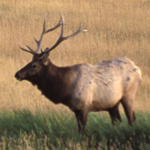|
HOME --> CLASS MAMMALIA
--> ORDER ARTIODACTYLA
--> FAMILY Bovidae
--> SUBFAMILY Caprinae
--> GENUS Ovis
SPECIES Ovis aries
| Author: | Linnaeus, 1758. | | Citation: | Syst. Nat., 10th ed., 1: 70. | | Common Name: | Red Sheep | | Type Locality: | "Habitat in siccis apricis calidis"; identified as Sweden by Thomas (1911a:153); domesticated stock. | | Distribution: | Urial or Arkar in Afghanistan, NW India (Kashmir), NE and SE Iran, SW Kazakhstan, Oman (introduced?), Pakistan, Tajikistan, Turkmenistan, and Uzbekistan. Intermediate Laristan sheep in S Iran. Red Sheep or Mouflon in Armenia, S Azerbaijan, N Iraq, W Iran, and S and E Turkey; transported populations (Mouflon) on Corsica and Sardinia, introduced from there to Europe, Ukraine (Crimea), USA (incl. Hawaiian Isls), Chile, Kerguelen Isls, and Tenerife (Canary Isls); and on Cyprus. Domesticated worldwide; feral populations on St. Kilda and other small islands off the British Isles; improved domestic stock feral in Norway, Sweden, USA, islands off coasts of United Kingdom and New Zealand, Kerguelen Isls, and probably other oceanic islands. | | Status: | CITES – Appendix I as O. orientalis ophion and O. vignei vignei, Appendix II as O. vignei; U.S. ESA – Endangered as O. musimon ophion and O. vignei vignei; IUCN – Endangered as O. orientalis ophion, O. o. bochariensis, O. o. punjabiensis, and O. o. vignei, Vulnerable as O. o. isphahanica, O. o. laristanica, O. o. arkal, O. o. gmelini, O. o. musimon, and O. o. cycloceros. | | Comments: | Includes orientalis; see Nadler et al. (1973). Also includes musimon and ophion, introduced in Neolithic to Corsica, Sardinia and Cyprus; see Payne (1968), Vigne (1988), and Hemmer (1990). For correct authorship of musimon, see Uerpmann (1980); Pallas (1811) included the Mouflon of Sardinia and Corsica described by Cetti with the Arkar of Turkmenistan and Iran as syntypes of musimon (Heptner et al., 1961). To avoid musimon being a senior synonym of arkal, the lectotype of musimon must be designated as a Corsican or Sardinian Mouflon. Gentry et al. (1996) proposed that majority usage be confirmed by adoption of Ovis orientalis as the name for the wild taxon of Red Sheep and asked the International Commission on Zoological Nomenclature to use its plenary powers to rule that the name for this wild species is not invalid by virtue of being antedated by the name based on the domestic form. A ruling has now been made in their favour (International Commission on Zoological Nomenclature, 2003a). It might still be valid for those who consider O. aries and O. orientalis to be conspecific to employ the senior name for the name of the species (see Bock, 1997), though authors have not referred to this species as O. aries when discussing wild populations; they have used the names O. ammon, O. gmelinii, or O. orientalis instead. Status of orientalis disputed; reputed type skull said to combine characters of Red Sheep, O. a. cf. armeniana and Arkar, O. a. arkal (Nadler et al. 1973; Valdez et al. 1978); type locality lies between habitat of Armenian Sheep and hybrid zone (see below); here treated as a senior synonym of armeniana, but provisionally listed as a subspecies of O. aries. Populations of the species can be partitioned into Red Sheep or Mouflon sensu stricto, the aries/orientalis division (includes also isphahanica, musimon, and ophion); and Urial or Arkar, the vignei division (includes also arkal, cycloceros, and formerly severtsovi, now transferred to O. ammon by Wu et al, 2003); Laristan Sheep, laristanica, combine Urial-type morphology and Red Sheep karyotype. Hence vignei and aries/orientalis divisions treated as conspecific following Valdez (1982); multivariate morphometrics (Ludwig and Knoll, 1998) did not discriminate between the two. Hybrid zone between O. a. orientalis (2N = 54) and O. a. arkal (2N = 58) in Elburz Mtns, N Iran and apparent hybrids between O. a. laristanica and O. a. cycloceros recorded in SE Iran (Nadler et al., 1971b; Valdez et al., 1978). Subspecies modified from Valdez (1982). |
|
| |
|
|



